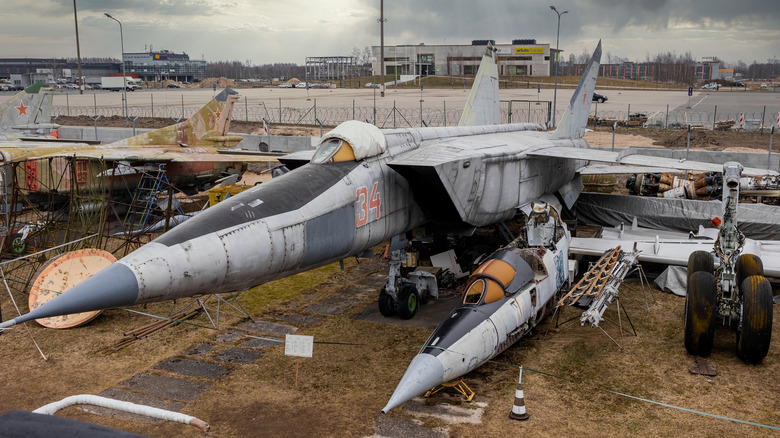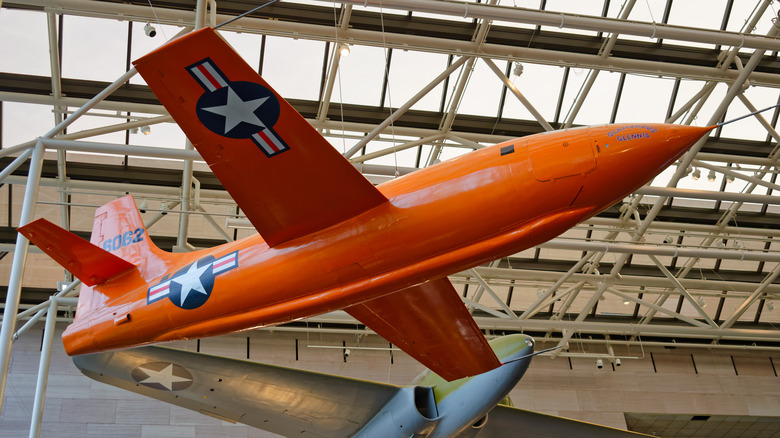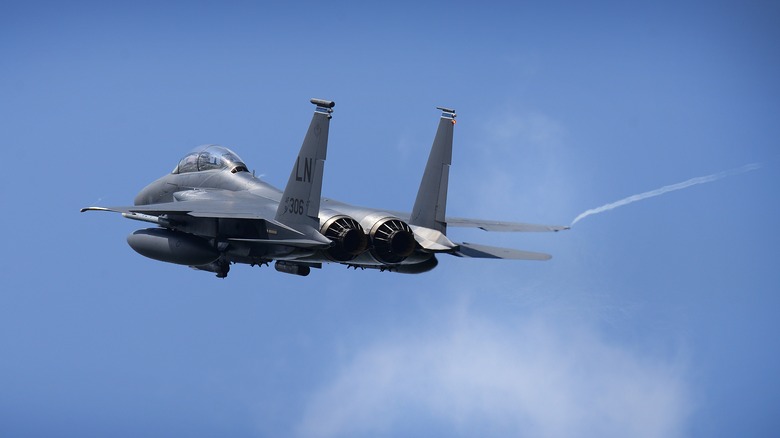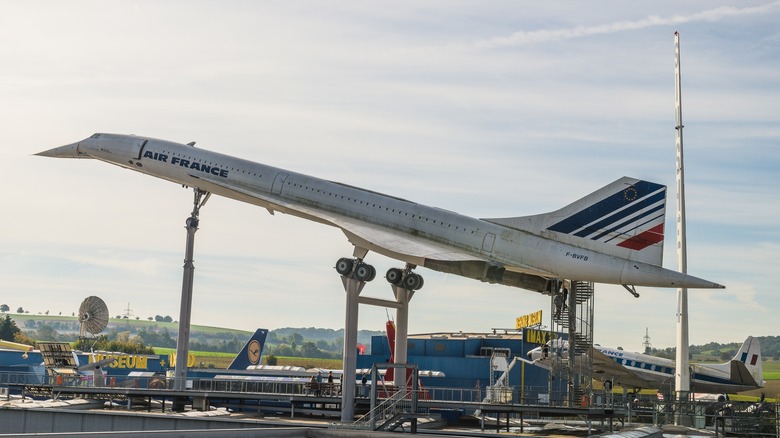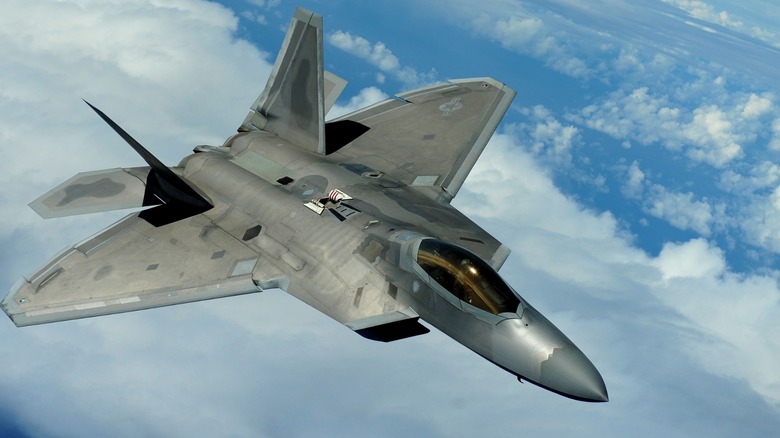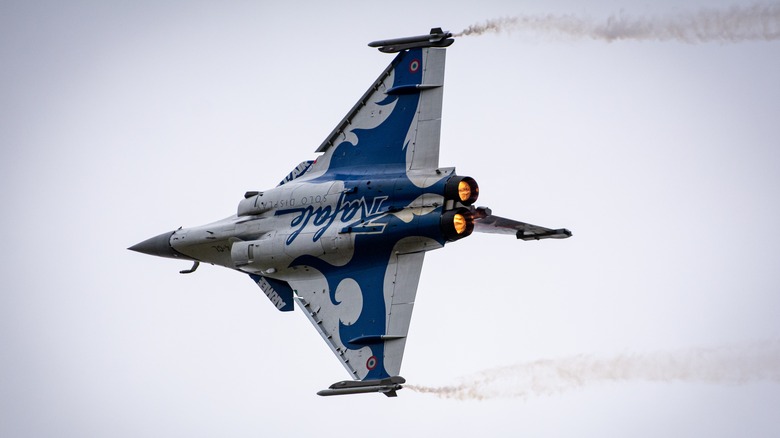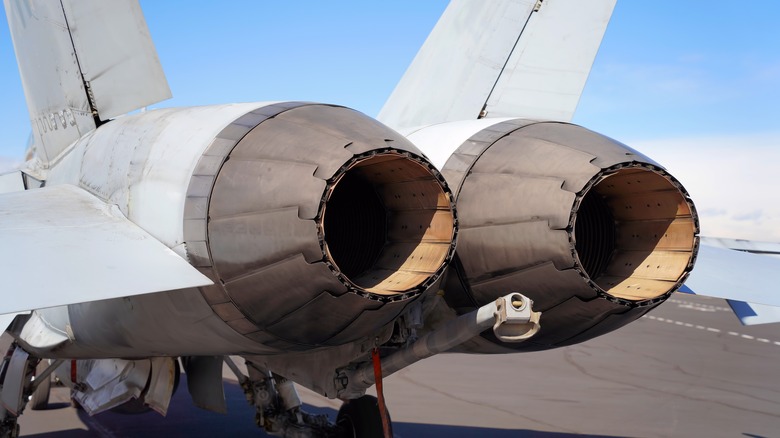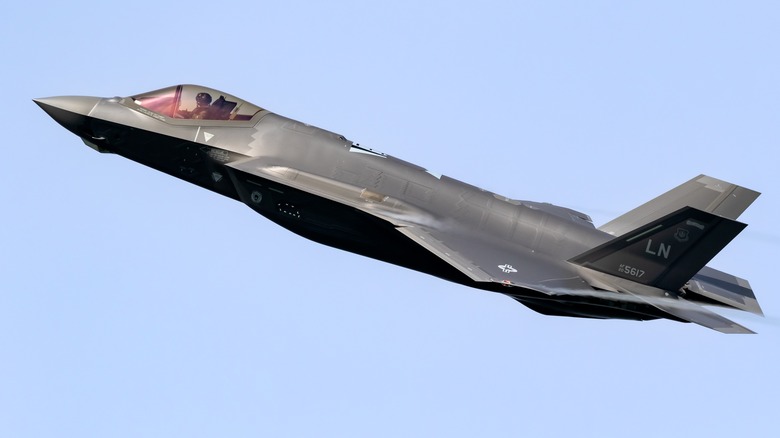From Take-Off To Supersonic: The Tech That Goes Into A Fighter Jet Reaching Top Speeds
Flight is a difficult notion to wrap your head around. Additional complexities, such as how tricky helicopter landings are performed or the mechanics of supersonic flight further complicate our understanding. Fighter jets in particular are capable of truly astonishing feats of agility, as any airshow admirer will tell you. Maneuverability can be key in enabling such aircraft to perform their combat/pursuit roles, and so these abilities are far from just for show. Another of their most unique capabilities is their raw speed. Guinness World Records declares Russia's 1978 Foxbat, the Mikoyan MiG-25, to be the fastest combat jet (the 'combat jet' specification separating the Foxbat from other aircraft that can hit even greater speeds), noting that "the reconnaissance `Foxbat-B' has been tracked by radar at about Mach 3.2 (3,395 km/h 2,110 mph)."
Traveling at over three times the speed of sound, needless to say, is the exception, not the norm, and your average Airbus can hit only a fraction of that. Even for aircraft that can achieve supersonic speeds, their ability to reach and maintain them is limited by the realities of that same flight. Technologically, supersonic aircraft are very different from their subsonic counterparts, and a supersonic flight itself is a very different sort of feat. Here are some ways that a supersonic aircraft's anatomy deviates from its slower counterparts, the components that allow it to achieve such speeds, and what happens during the course of the flight of an aircraft like the MiG-25.
The rocket-powered Bell X-1 and the development of supersonic flight
Humanity has been wielding supersonic aircraft for almost eighty years, since Chuck Yaeger's iconic flight in October of 1947. Part of the impetus for this experimental flight, of course, was simply to demonstrate the exciting possibility, but it was a journey that would be the forerunner of the supersonic aircraft of today. The Bell X-1 reached Mach 1.45 on its fastest trip, an astonishing feat for its time that was performed by an aircraft with both enormous similarities and differences to the fighter jets that followed it.
It is important to note that, unlike the low-bypass turbojet engines that power military jets today, the X-1 was powered by a rocket engine. That said, it still helped engineers understand flight at such blistering speeds. The long and thin metal body followed a design philosophy that would become rather characteristic of fighter jets, including a stabilizer that could be adjusted to help support it at great speeds and wings that were resilient without adding a great deal of weight that could compromise performance (a particular concern for an aircraft that already had to house around 500 lbs of scientific equipment).
The smooth, bullet-like design of the aircraft was a forerunner of drag-reducing capabilities like the carefully balanced thrust-to-weight ratio of the United States Air Force's F-15C and D (which weigh 31,700 pounds and have a thrust of 23,450 pounds in each of its pair of F-100 engines). The F-14 built upon the swept wing configuration of fighter jets more broadly by making the angle adjustable, thereby allowing the plane to respond to the effects of drag and mitigate them whether flying supersonically or not.
The engines that power supersonic aircraft
In the United States' arsenal, the F-15E Strike Eagle is one of the fastest fighter jets ever made. At approximately Mach 2.5 or 1,875 mph, it's an astonishing aircraft with a sleek and aerodynamic body. To achieve such pace, the most important thing an aircraft needs is an engine that is actually capable of it in the first place. The Strike Eagle boasts dual F100-PW-220 or PW-229 engines. Armed with such a sophisticated and potent powertrain (each PW-229 can provide 29,000 lbs of thrust), the aircraft is capable of flying at heights of up to 60,000 feet and has a range of 2,400 miles.
Performance is key, and the F-15E's engines boast computerized controls that allow for blistering acceleration: "from idle power to maximum afterburner in less than four seconds," says the United States Air Force. Fifth-generation fighter aircraft, meanwhile, are capable of even more astonishing feats. The F-35 Lightning II houses Pratt & Whitney's F135, which carries the aircraft up to Mach 1.6. It's a single-engine model, offering 43,000 pounds of thrust (helping explain why only one engine is needed), but there's more to the equation than just speed. This engine also boasts Engine Core Upgrade technology, meaning that it can more easily manage its temperature and waste less fuel. Both of these factors can have huge influences on supersonic flight, making this functionality a boon.
When a supersonic aircraft takes off
The F-15 Eagle from McDonnell Douglas typically takes off at between 120 and 150 knots (around 139 to 172 mph). As such, when it comes to the flight of supersonic aircraft versus subsonic, the action can at least begin in a strikingly similar fashion. They don't necessarily have to, though: Not all fighter jets need to zoom across great stretches of runway before they leave the ground.
Unlike commercial aircraft, they often need to be more versatile than that. The F-35B is one fighter jet that features a very special capacity known as Short Take Off Vertical Landing, or STOVL. LiftFan technology from Rolls-Royce enables this functionality, which sees the engine's considerable thrust partially directed downwards, essentially helping it to take off vertically as a helicopter does.
The enormous advantage of such a feature, of course, is that it makes a jet fighter far more versatile (and versatility is often key to such aircraft) to deploy, should they need to do so from a busy aircraft carrier or location with limited runway space. An even more advanced version of such tech is VTOL (Vertical Takeoff and Landing), as employed by such jets as the AV-8B Harrier II. In other models, tiltrotors are used to change the direction of that driving force. "The wing then provides lift, and the rotor provides thrust like a propeller," the National Air And Space Museum explains.
Accelerating from subsonic to supersonic speeds
Having taken off at a distinctly conventional speed, you might think that a fighter jet could simply floor it and happily accelerate towards its max speed uncontested. As it is, though, there are some vital changes to accommodate supersonic flight. A "How Things Fly Demonstration" on supersonic flight from the Smithsonian National Air and Space Museum notes that "At 760 miles an hour air compresses, shockwaves form on the wings, and drag increases dramatically." Drag is partially generated by the interaction between the air and the body of the aircraft, and the effect of this friction is lessened by more sleek and aerodynamic designs.
Drag, then, is an effect against which aircraft designers, pilots, and the aircraft itself must battle. The greater an influence it has, the more detrimental effect it can have on the speed of an aircraft. In a sense, then, the maximum speed of a supersonic plane is partially determined by how aerodynamic it is.
Careful design of the wings is also paramount. For the iconic and innovative commercial jet Concorde, the anhedral and continuous camber design, combined with its thickness/chord ratio as low as 2.15%, was tailored to ensure the wings were as drag-resistant as they could practically be. It's not just the wings of such aircraft that require special attention, either.
The logistics of hitting supersonic speeds
What happens when an aircraft hits around 760 mph, or the average speed of sound, then? The best-known element of supersonic flight is the sonic boom that typically heralds it. A loud, thunderous crash — sonic booms are generated by the reaction between the molecules of the air and the aircraft speeding through it. A shockwave is generated as they're pushed aside, and the wave follows in the aircraft's wake. As a result of this, a sonic boom does not constitute just one single blast of noise but a lasting disruption.
Noise mitigation, with regards to the booms, is vital to bear in mind (and a reason why the Concorde ultimately wasn't viable because it was restricted from flying at supersonic speeds over land). Another factor to consider is the heat mitigation needed when performing supersonic flight. Projects such as the Royal Air Force's Team Tempest report that "developing advanced composite materials and additive manufacturing to produce lightweight, power-dense configurations capable of operating at higher temperatures" is important to these efforts.
The Tempest is currently planned to succeed the accomplished Eurofighter Typhoon, a role it's intended to adopt within the RAF in 2035. "We are working on creating a payload bay that can handle the noise, vibration and other challenges of supersonic speeds," the RAF notes, demonstrating that the ongoing work on the Tempest seeks to address some pressures supersonic flight can have on an aircraft.
The importance of the afterburner
Having taken off into the air, the next step is to accelerate to supersonic speeds when called for. With a lot of fighter jets, the process is facilitated by means of an afterburner. While fighter jets boast potent engines with formidable thrust, they sometimes need an extra 'push' to overcome the drag experienced at supersonic speed. Flight at and around 760 miles per hour sees an aircraft encounter drag that requires extra thrust from the afterburners.
Turbojet engines, then, typically feature an afterburner, a feature that injects fuel directly into the hot exhaust stream for a burst in thrust. An afterburner, however, isn't a supersonic speed cheat code and must be used sparingly. It both helps enable and strictly limits a jet engine's supersonic abilities.
An afterburner is a simple structure that can increase thrust by approximately 50% or more, but the drawback of use of such a device is a significant one: The fashion in which the fuel is used means that it is burnt through. Afterburner use has an associated heavy cost in fuel use that lets down an otherwise-efficient engine, meaning that supersonic flight often cannot be maintained for any longer than is strictly necessary.
Supersonic fighter jets don't typically go supersonic
Even models such as the formidable F-35, which is capable of hitting Mach 1.6 thanks to the F135 (deemed by Lockheed Martin to be "the most powerful fighter engine in the world"), mostly avoid doing so. In June 2019, a protracted supersonic flight caused damage to the tail structure of an F-35C and the special stealth coating painted on the tail of an F-35B during test flights in late 2011.
These were reportedly exceptional cases that occurred during flights at the very limits of the aircraft's capacities, but they demonstrate that even aircraft designed for supersonic flight may not be able to sustain it for very long. In the case of the F-35, Defense News reported the following year that Pentagon guidelines had restricted Mach 1.3 flights to 40 cumulative seconds and Mach 1.2 to 80 seconds for the F-35B and 50 seconds for the former with the 35C.
In April 2020, the Hudson Institute's Bryan Clark told Defense News that supersonic was a real rarity among F-35 pilots. "It takes you out of stealthiness ... burns gas like crazy so you lose the range benefits of a single engine and larger fuel tank. When you go into afterburner, you are heating up the outside of your aircraft," Clark said, indicating that niche uses in pursuing or evading a target over very brief bursts can be the most practical use of supersonic flight capability, given its shortcomings in practical military operations.
